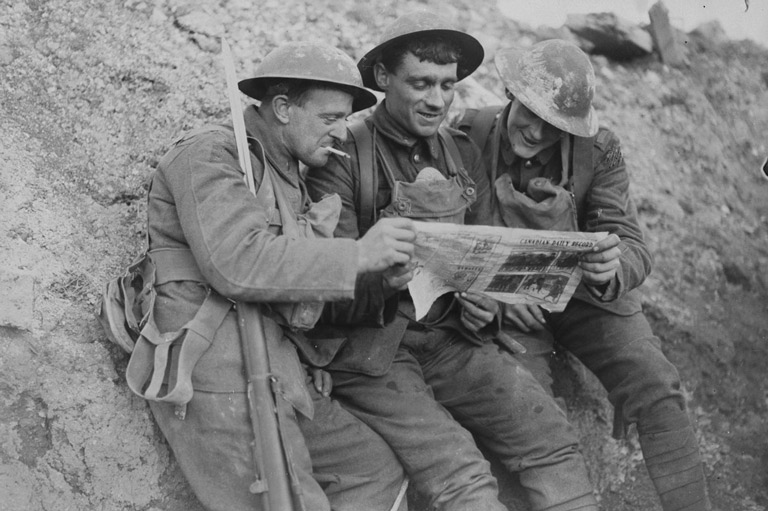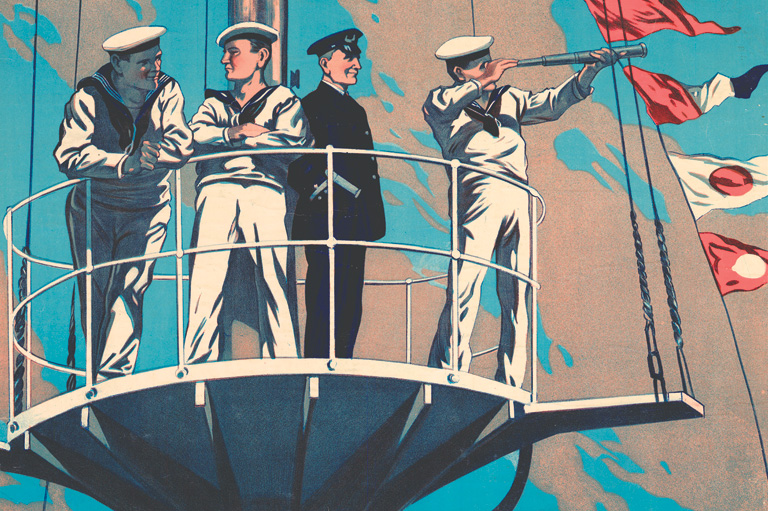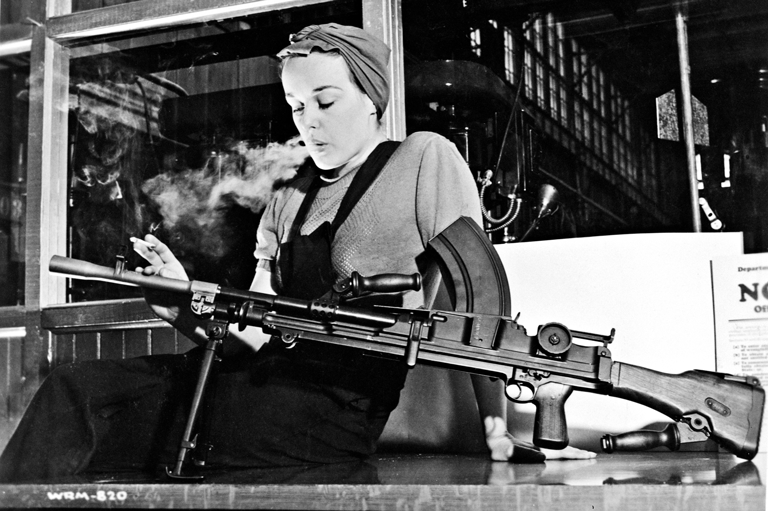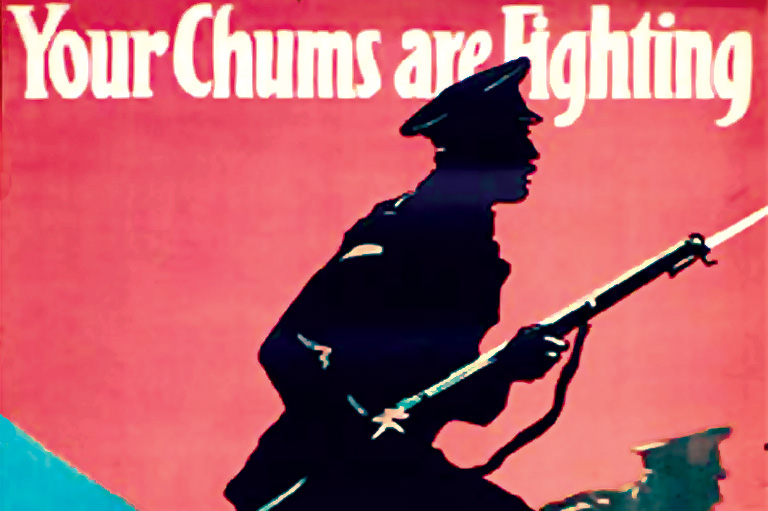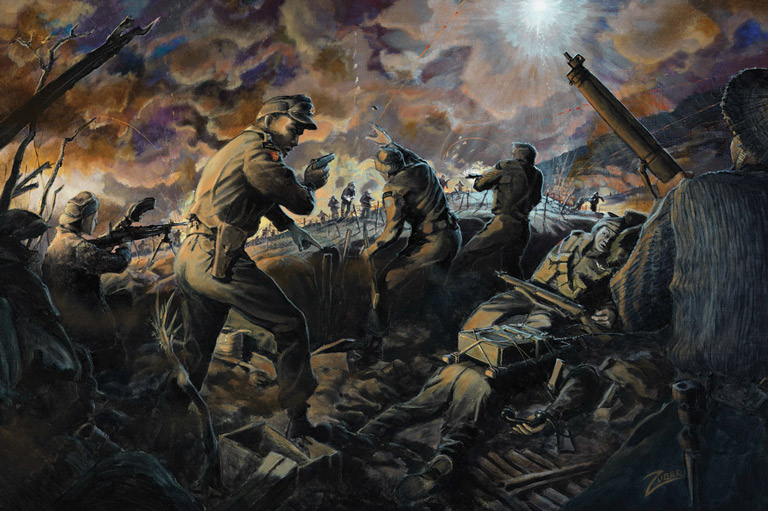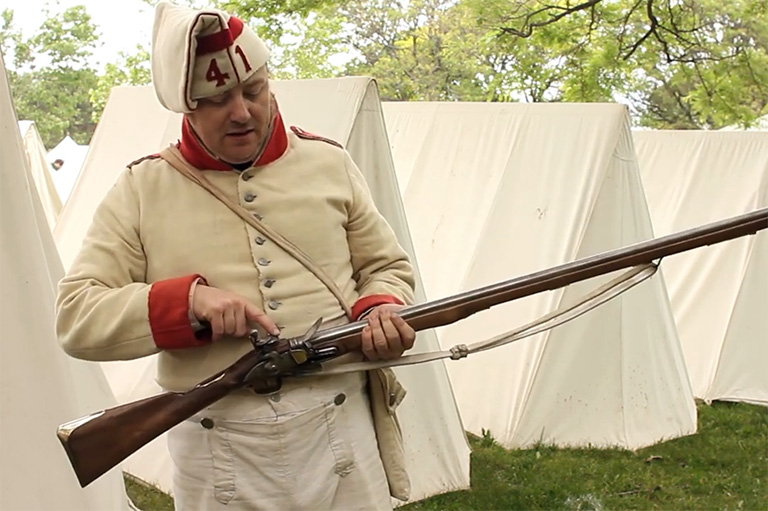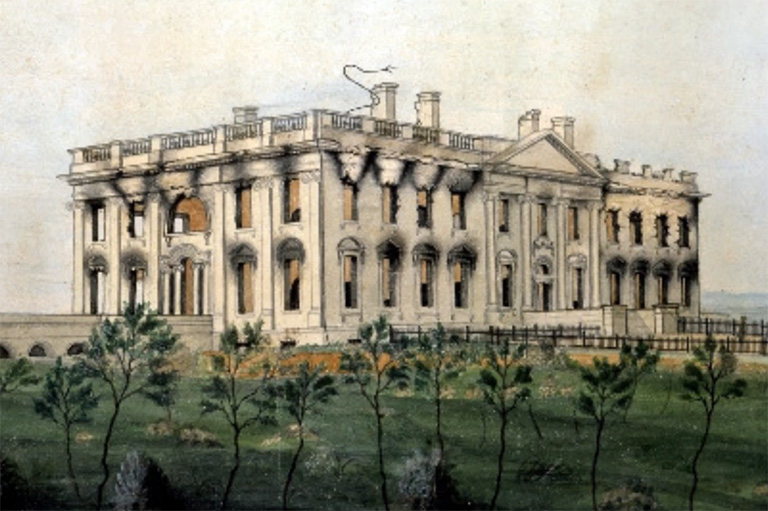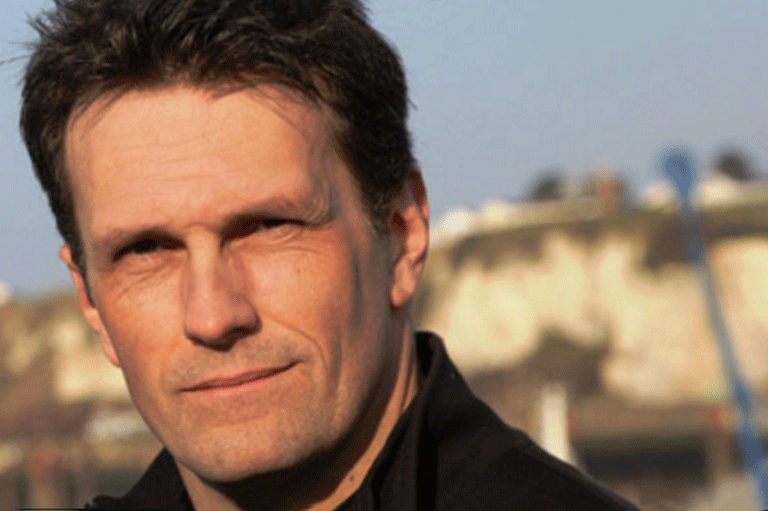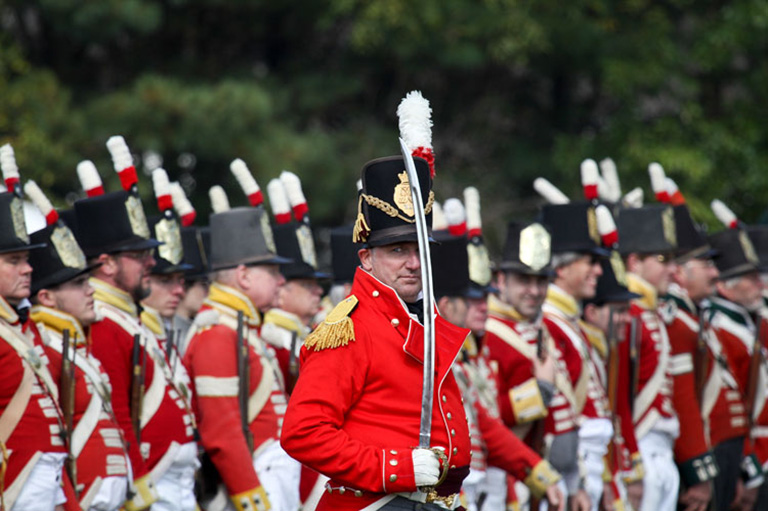Over the Top
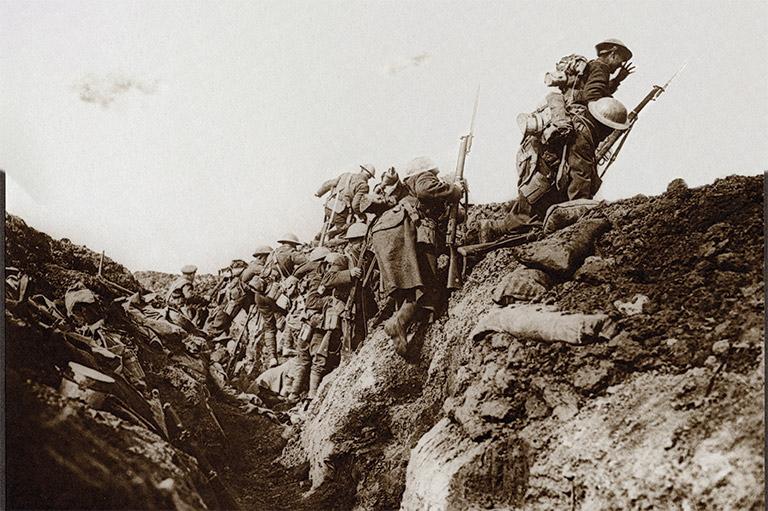
When the Canadian exhibition of official First World War photographs travelled from Britain to North America in 1917, it was acclaimed in the press for its ability to bring the war home. The photographs felt lifelike in size and immediacy. Audience members in four Canadian cities reportedly recognized the faces of loved ones. The centrepiece of the exhibition was a huge photographic print showing Canadians bursting from a trench, bayonets raised. If audiences wanted to know what war looked like, this was it.
When the show arrived in the United States in 1918, the New York Evening Post wrote: “The most remarkable of all the pictures is that of the Twentieth Battalion, Canadians, sweeping over the top in the charge which carried them into Courcelette [France]. It is the first wave of the attack which is shown, almost all the men in which were killed at once; and several mothers have been able to see how their sons looked the very second before they were killed, as they rushed into view, laughing.”
Had someone reading a newspaper or visiting the exhibition in New York done the same in London two years prior, they may have noticed that the stories surrounding the same photographs were vastly different. Canadians Charging on the Somme — one of four photographic images in a series that showed soldiers preparing for and embarking on a battle — first appeared in British newspapers in October 1916. But it wasn’t described as showing the 20th Canadian Infantry Battalion at the Battle of Courcelette. There was no mention of the soldiers in the picture being cut down by enemy fire just moments after the photograph was taken. Remarkably, descriptions of the photographic series became more detailed and elaborate as the war carried on.
But none of them was true.
The series of four photographs was taken by the Canadian Corps’ official photographer, Ivor Castle, during a training session at Saint-Pol-sur-Ternoise, France, in October 1916. Throughout the war and afterwards, the series took on different narratives and meanings, and its myths eventually became the subject of historical dissection.
Images from the series are often used today as representations of battle, and — although they might be classified as realistic, if not real — their significance as a photographic series is derived from the way in which they reveal the conventions and constrictions of First World War-era reportage.
With 7 uniquely curated newsletters to choose from, we have something for everyone.
When war broke out in 1914, Canadian and British military authorities were fearful of photography’s potential on the Western Front. It was believed that the camera could not lie. But this belief presented a specific set of challenges during times of war: Photographs could reveal sensitive military information, and they could affect morale on the home front. Press photographers were banned from the Canadian and British sectors of the Western Front, and soldiers were likewise banned from sending photographs home.
None of these measures could stand in the face of an overwhelming public demand for photographs. As Sir Max Aitken, a.k.a. Lord Beaverbrook, head of the Canadian War Records Office (CWRO) argued, visual images were essential in connecting the home front to the Western Front. Even more than written accounts, photographs had the power to persuade audiences to support the cause. Beaverbrook, a millionaire newspaper magnate and Canadian expatriate in London, had established the CWRO in January 1916 with a $25,000 government grant and his own funds. The office’s initial task was to collate records of the war for posterity, but it went on to create propaganda to bolster the Canadian war effort and to raise the international profile of Canadian soldiers. As Beaverbrook explained, “We must see our men climbing out of the trenches to the assault before we can realise the patience, the exhaustion, and the courage which are assets and the trials of modern fighting men.”
By 1916, military and government authorities decided to hire official photographers whose work would be tightly controlled. The British Propaganda Bureau hired two photographers, while the CWRO hired one.
Canada’s first official photographer was Captain Harry Knobel, who served for only a few months before the horror of the war overcame him and he returned to Canada. Ivor Castle, a thirty-nine-year-old British press photographer, succeeded Knobel in August 1916. Castle had worked as a photographer for nearly twenty years, travelling the world and witnessing international conflicts — all while sending postcards home to his wife and sons.
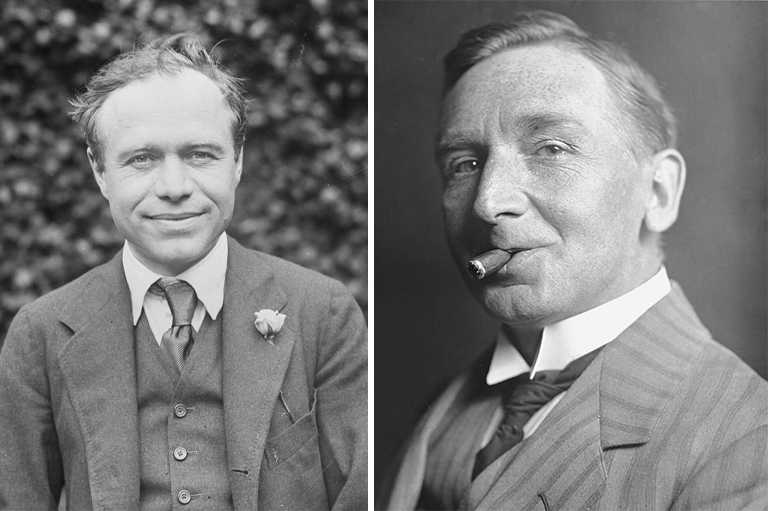
Castle and Beaverbrook proved to be a dynamic team. Beaverbrook hoped to raise the profile of the Canadian Expeditionary Force through newsreels, books, magazines, exhibitions, and the illustrated press. Castle was just the man: Like many press photographers of his era, he hoped to create images that would take on a life beyond the daily news cycle. Beaverbrook allowed Castle to stage and manipulate his photographs of the Saint-Pol-sur-Ternoise training session in order to create a spectacle, while the public perception that the camera couldn’t lie readily cemented their status as a genuine battle series. It would be the first, but not the last, international sensation carefully crafted by the two men.
The photographic series consists of four images taken in sequence. To make the first image, Fixing Bayonets Previous to a Charge by Canadians on the Somme, Castle stood in the trench to the right of the men and photographed at a range close enough to make viewers feel like participants in the activity. The men were laden with gear and carried practice rifles with canvas breech covers, while additional equipment was scattered along the trench wall behind them. As Maureen Magerman, a photographic historian at Luca School of Arts in Belgium, has demonstrated, during the process of developing and printing the photos, the breech covers were removed through image manipulation and replaced with standard breeches, and new hands were drawn in.
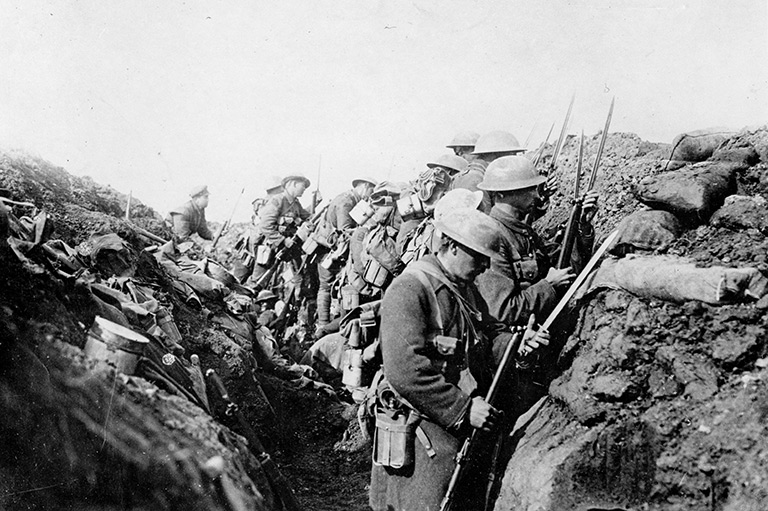
In the next shot, A Canadian Battalion Go Over the Top (See photo at the beginning of the article), Castle tilted his lens toward the top of the parapet to show men scrambling over. Shells bursting in the background were later added to the scene from other negatives. In many versions of the final print, the first man out of the trench appears to be making a curious gesture with his hand.
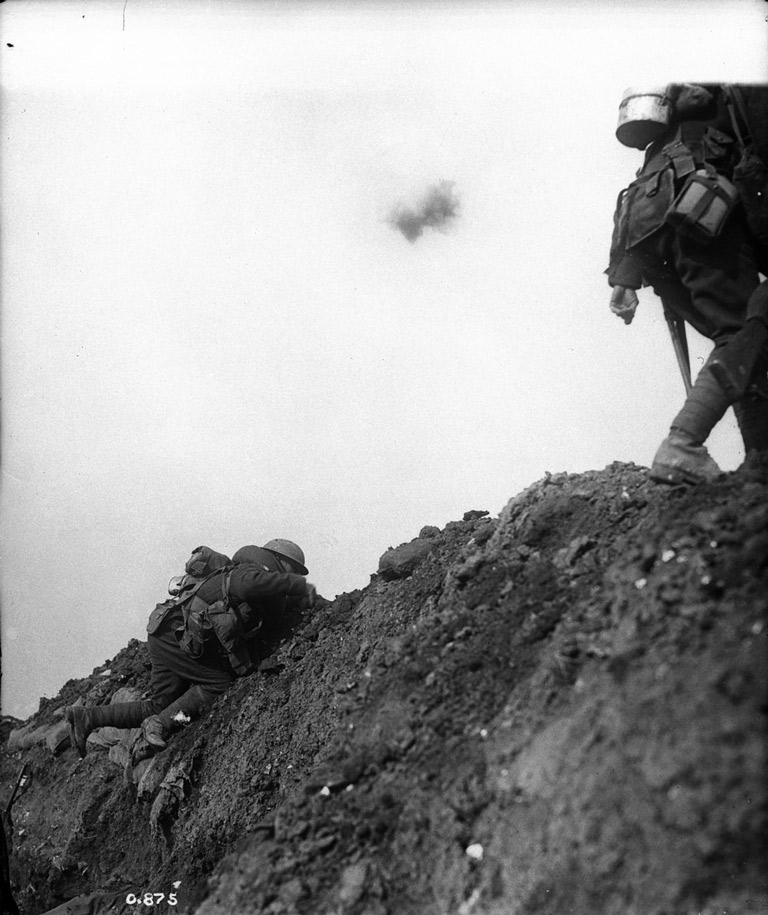
The third photograph, The Last Over the Top, shows the back of a man who has made it over the top, to the right of someone crawling on his belly out of the trench. A single shell bursts in the sky between the two men — added to the image during the printing process — and much of the foreground is occupied by dirt and sandbags. Prints of this image feature framing that is incongruent with the other shots: It’s the only one with a significant piece of visual information escaping out of the frame. In the version of this photograph printed in the Illustrated War News in 1916, the upright man has a breech cover on his rifle — a telltale sign that the photograph was taken during a training session. However, for the purposes of official exhibitions, the photo was cropped to remove the rifle — which explains the unusual framing.
Finally, for Canadians Charging on the Somme, Castle stood facing the group of soldiers who ran towards a supposed enemy. In the resulting image, their bayonets pierce the sky and their helmets gleam in the sunlight. To get this shot, Castle would have had to stand with his back to a presumably firing enemy, or in the way of a Canadian artillery barrage — a level of bravado that newspapers would celebrate repeatedly.
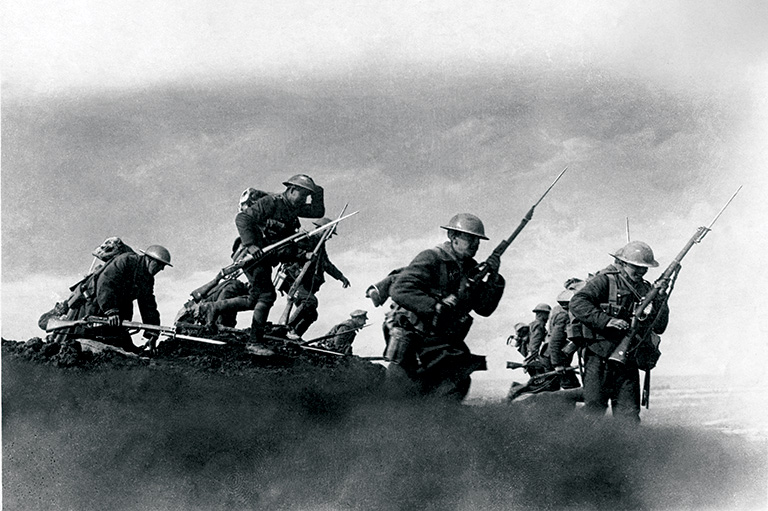
London audiences got their first glimpse of the photo series on October 16, 1916, after the photographic negatives had been handed out to the press by the CWRO. The Daily Mirror’s front-page spread featured a tightly cropped version of Fixing Bayonets Previous to a Charge by Canadians on the Somme, next to Canadians Charging on the Somme. Below was a third photo of a landscape with shells bursting. The three images comprised a short visual sequence: Soldiers prepare, soldiers attack, soldiers face enemy fire.
Based on false information supplied by Castle and the CWRO, the Daily Mirror described the images as “A Charge by the Canadian Troops on the Somme Front” and claimed: “In this attack many of the men were laughing as they clambered out of the trench and made their way across the open to meet the Boche at close quarters.” This text set the tone for how the photographs would repeatedly be described during the war: Canadian soldiers are light-hearted in the face of enemy danger. The caption stated that Canadians had captured key areas along the Somme, including “the stronglyfortified village of Courcelette,” but avoided ascribing the photos to any particular battle.
A similar approach was taken almost three weeks later by the Illustrated War News, a London-based pictorial weekly. Alongside the headline “Canadians Answer the Signal on the Somme,” the article remarked on the steely discipline of the Canadians, who faced a “veritable hell of gunfire” but showed no fear. This fulfilled the CWRO’s propaganda mission of showing close-up photographs of men who were fearless in the face of danger. Audiences could be thrilled, but not terrified.
Save as much as 40% off the cover price! 4 issues per year as low as $29.95. Available in print and digital. Tariff-exempt!
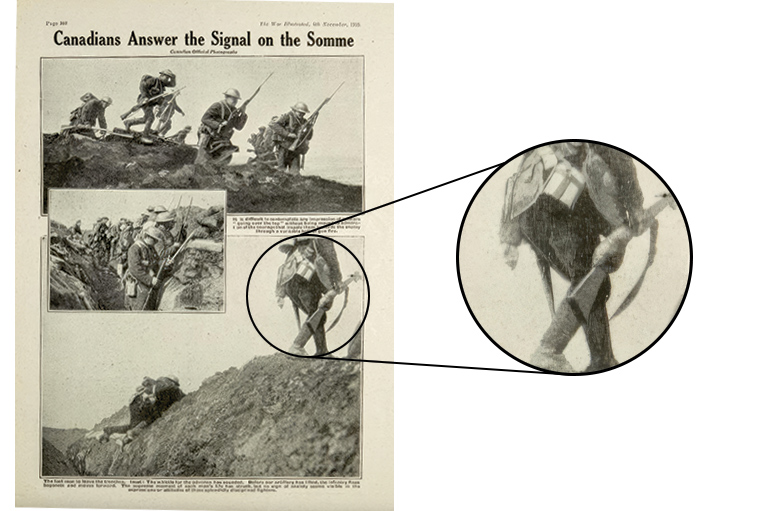
Although Castle staged that particular photographic series, he also worked on and behind the front lines, taking bona fide pictures of soldiers’ wartime experiences. After being vetted by a field censor, his glass-plate negatives were sent to the CWRO, where they were numbered and given captions. After further censoring by the War Office, the photographs and captions were distributed to the media through London’s Central News Press Agency. This turnaround typically took a few days to complete.
Before the year was out, A Canadian Battalion Go Over the Top graced the cover of the CWRO’s Canadian War Pictorial. Two additional images from the series were published inside, in a lengthy article on the Battle of Courcelette — a part of the Somme offensive during which Canadian troops successfully captured the ruined village of Courcelette on September 16, 1916. The Canadian War Pictorial article appears to be the first instance in which the photographs were positioned alongside actual images of the Battle of Courcelette, within the context of a story that specifically described that battle — publicly pinpointing for the first time the supposedly true (but actually false) date and location captured in the photos.
Photographs from the series were mounted in Canada’s first exhibition of official war photographs at Grafton Galleries in London, England, in December 1916, with Canadians Charging on the Somme as the centrepiece. They were shown among more than 150 additional images, including prisoners of war, ruined villages, life behind the lines, munitions, celebrations, and souvenirs. The show was opened by Sir George Perley, Canada’s Minister of the Overseas Military Force, with his wife, Lady Perley, Queen Victoria’s granddaughter Princess Patricia, and Lord Beaverbrook in attendance.
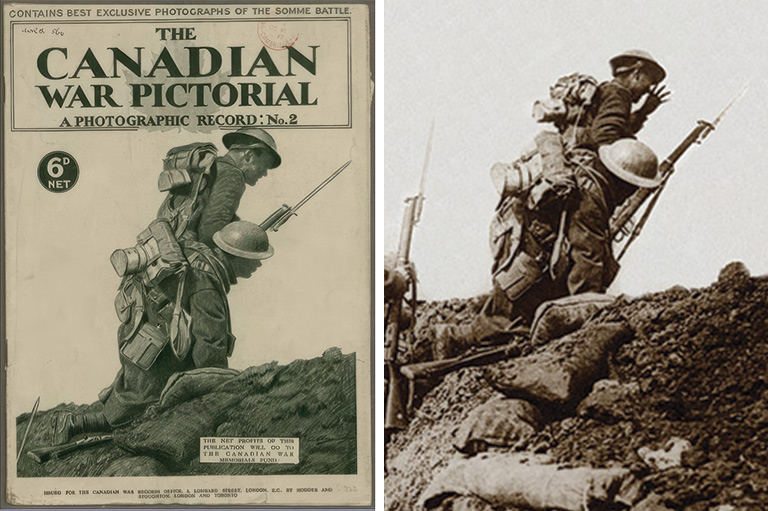
The catalogue fabricated specific stories around the pictures: It claimed that Canadians Charging on the Somme showed “the Canadians sweeping over to the charge which carried them into Courcelette. 20th Battalion — First wave of the attack” and that The Last Over the Top depicted “a German shrapnel shell bursting over a Canadian trench just as the Canadians are going over the parapet. A fragment from this shell killed the man whose body is seen sprawled across the parapet.”
The exhibition received rave reviews. As the Daily Mirror remarked: “The exhibition constitutes a record in war photography. Nothing like it has ever been seen before.”
The photos’ claims to authenticity were solidified by contemporary attitudes about the photographic medium, but it was likely Castle’s own stories about the images that truly sealed the deal. He was, in his telling, the intrepid photographer who put his back to enemy shellfire to photograph Canadians in battle. As the Times (UK) reported, Castle was busy each day at the exhibition “among the guests explaining the various points of the great battle scenes.” As a result, “everyone has been deeply impressed by the realism of the pictures and their striking portrayal of war.”
Castle took this a step further when, for a 1917 article in the CWRO publication Canada in Khaki, he offered fictitious anecdotes about photographing on the Somme. “Taking photographs of the men going over the parapet is quite exciting. Nothing, of course, can be arranged. You sit or crouch in the first-line trench while the enemy do a little strafing, and if you are lucky you get your pictures,” he wrote.
The false origin story that Castle and Beaverbrook created for the series of photos taken at the Saint-Pol-sur-Ternoise training session opened the door for numerous other fabrications. And while Castle and Beaverbrook chose to present the photographs as depictions of the Battle of Courcelette — when conceivably they could have become anything — in the following year they became stand-ins for everything.
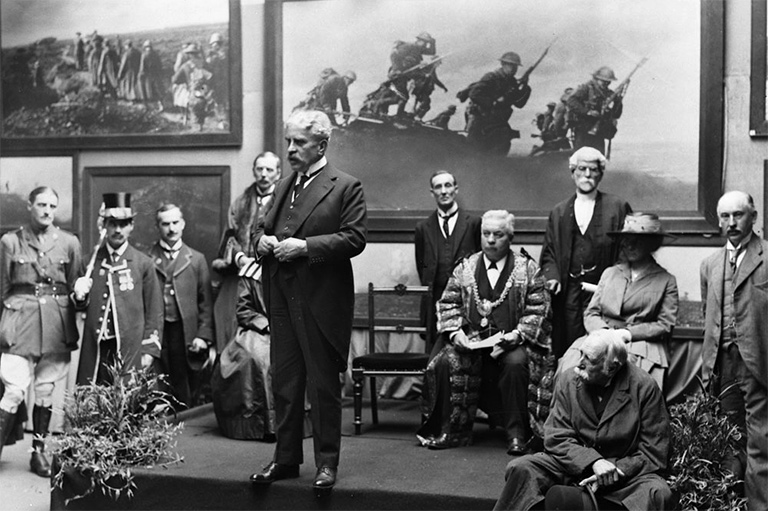
Photographs from the series popped up in newspapers occasionally in 1917 — this time to represent completely different battles, absent actual photographs of those events. On April 11, the Daily Mirror published A Canadian Battalion Go Over the Top to accompany a report on the Battle of Vimy Ridge — a four-day offensive that began on April 9 — five days before Castle’s actual photographs of that battle had time to travel from the front line to the pages of London’s newspapers. Though the accompanying caption remarked on the success of the Canadians at Vimy Ridge, the photograph itself was labelled as Canadians on the Somme — an attempt at editorial accuracy, which perpetuated the original, official falsehood surrounding the photo.
Later that year, the Glasgow Daily Record published both Fixing Bayonets Previous to a Charge by Canadians on the Somme and Canadians Charging on the Somme — this time to accompany news of the ongoing Battle of Passchendaele. The captions didn’t mention that the photographs were not taken during the Battle of Passchendaele — in fact, they were not ascribed to any particular battle. Similarly, France’s Le Miroir published A Canadian Battalion Go Over the Top on November 18, 1917, also to report on the Canadian attack on Passchendaele. A line in Le Miroir’s story described the photographs as the beginning of the attack to take Passchendaele village.
The exhibition of official war photographs crossed the Atlantic in 1917. During its stops in Canada, numerous newspaper articles remarked that spectators recognized loved ones in the photographs — a marvel that would be repeated in the press as the exhibition moved on to the United States. The questionable veracity of these stories aside, they highlight the CWRO’s purpose for exhibiting photographs: People should attend exhibitions with the desire to find resonance, or familiar faces, in the photographs.
Accompanying the tour was Major Maurice Stanley Boehm, a forty-one-year-old who had vaguely described himself during his enlistment as a “managing director.” Boehm’s Great War was brief: He sailed to England in October 1916, was transferred to the Canadian War Records Office by late February 1917, and sailed back to North America with the photographs in early April.
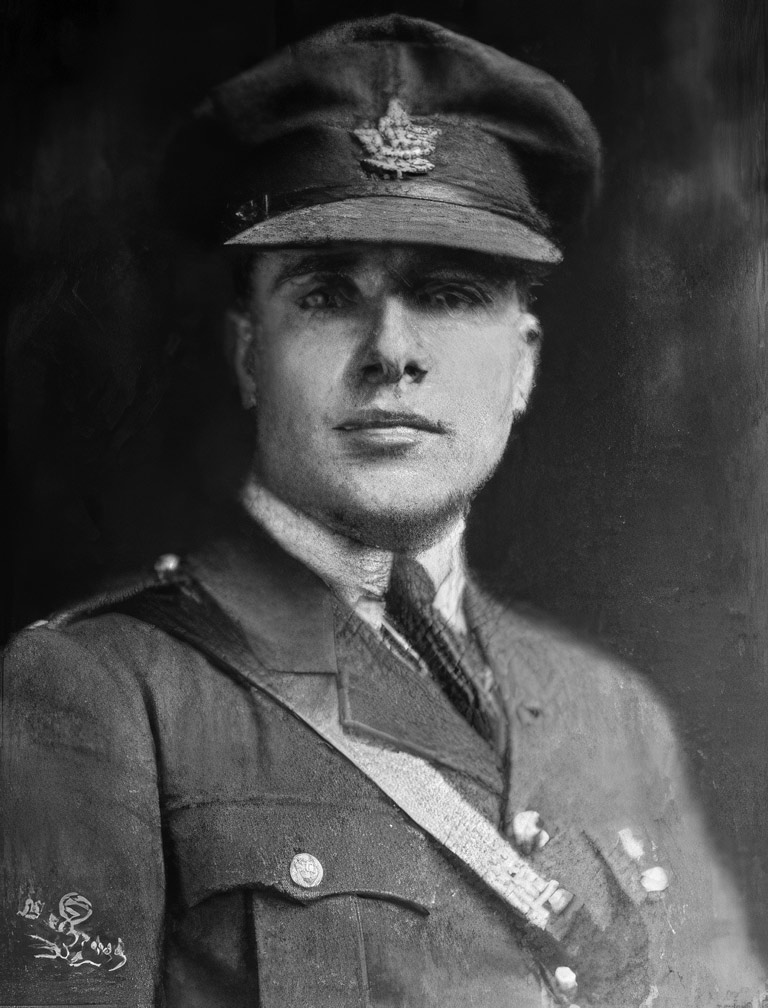
For the American leg of the tour, Boehm brought along twenty-eight-year-old Lieutenant Harry Gordon Milsom — a man the New York Evening Sun claimed knew just about everyone in the photographs. Milsom was born in Ireland and enlisted from Canada in September 1914. His wartime service was plagued with constant illness, and he had been found unfit for anything beyond light home service in the fall of 1917. Thus, he joined Boehm to help to promote the war effort. Just as Castle had done in 1916, Boehm and Milsom offered tours and lectures as the exhibition travelled across the United States — and those two men may have been the sources of the new, even more fantastical tales that appeared in the press.
The New York Sun reported in May 1918: “One group shows a platoon going over the top. A minute after the picture was snapped the unit was decimated by machine gun fire.” The New York Evening World offered up a similar story: “One minute after the picture was taken a German machine gun found the squad and sprayed bullets on them. They were all killed.” The Evening World provided additional details on Castle’s purportedly death-defying bravado in taking the photo: “Capt. Castle was not ten feet away, half buried in a shell hole, when he snapped it.”
The New York Mail elaborated on the story of Castle’s proximity to the soldiers as they died, stating: “It spattered his helmet and left him unharmed, but when he lifted his eyes not a man in the group he had just snapped was standing. A well-directed volley from a German machine gun had swept them into eternity.”
Finally, the New York Globe and Commercial Advertiser repeated the story that all of the soldiers in the photo had been killed. It added: “All of these men have been identified by their mothers, who have thus been able to buy, as their poor comfort, the pictures of their sons, taken a moment before their bodies hurtled back into the trench from which they had sprung, smiling.”
Besides raising money for the Canadian War Memorials Fund, the North American exhibition tour was also intended to stir up support for the war effort and to ignite industrial production, particularly shipbuilding. During his stops in Boston and New York, Boehm reportedly declared that the Allies must “exterminate the Hun” and that it would take the help of six million American men. This came at a time when the German Spring Offensive of 1918 had caused more than three hundred thousand Allied casualties, and when the Allies were awaiting the full deployment of the American Expeditionary Forces in Europe. Castle’s series of staged photos was no longer just a stand-in to illustrate Canadian battles; it became a rallying cry across the United States.
Perhaps one of the wildest stories came months after the exhibition had left New York. The August 30, 1918, cover of the Amateur Photographers Weekly featured Canadians Charging on the Somme, while A Canadian Battalion Go Over the Top accompanied a short article inside the issue.
The writer claimed that Castle was with another photographer who died during the battle. It went on to explain: “It will be noted that all the men in it are smiling except one. This is said to be typical of the men as they go over. The unsmiling one had a grouch, because, having managed to get some ‘booze’ the night before, he had received not only punishment but also a ‘big head.’ Curiously enough, he was one of the three to come back alive.”
The source of this story is not clear. While the photograph’s origins were falsified from the start, the CWRO effectively created an environment wherein nothing was true, so anything could be claimed. It would take decades for historians to begin to chip away at the myths surrounding the photographic series.
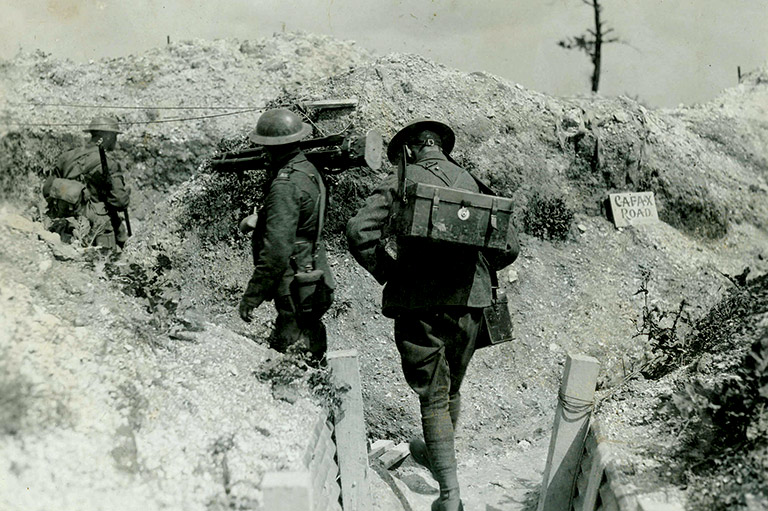
The meaning attributed to the four photos taken at the Saint-Pol-sur-Ternoise training session shifted from 1916 to 1918 to suit the needs of the Canadian War Records Office and the broader Canadian war propaganda effort. Castle supplied stories claiming that he had risked his neck in battle, and he fabricated scenes to act as proof, all while knowing that audiences would believe the photographs to be genuine. Beaverbrook supported, and even encouraged, Castle’s darkroom skills, knowing that audiences ultimately needed to see such photographs to really believe what was happening in France and to lend their continued support for the war. Audiences needed to bring the war home, and these photos — along with the dozens of other photographs exhibited in Europe and North America — ultimately achieved that goal. As historian Jennifer Wellington states, what audiences witnessed on the gallery wall or the printed page mattered far less than what they believed they saw.
Orders of Canadian official photographic prints were tallied in the thousands as the war reached its final days. The demand eventually tapered out; but in 1934, upon the twentieth anniversary of the beginning of the war, the Toronto Daily Star and the Winnipeg Free Press each ran hundreds of photographs. This time they reframed the photographs to question the validity of the conflict. Rather than pairing images with pro-war headlines, they pointed out what they believed to be the absurdity of battle.
The Toronto Daily Star paired A Canadian Battalion Go Over the Top with the caption: “They Have a Rendezvous with Death: Canadians at the Somme, leaving their trenches in one of the innumerable daylight attacks of that ill-omened battle, reckless, fed-up, exhausted with the mud, bludgeoned by incessant shellfire and counter attacks.” The true story of the photographs — staging battle to sell the war — would have supported such criticism of the conflict, but it remained uncovered for another thirty-seven years.
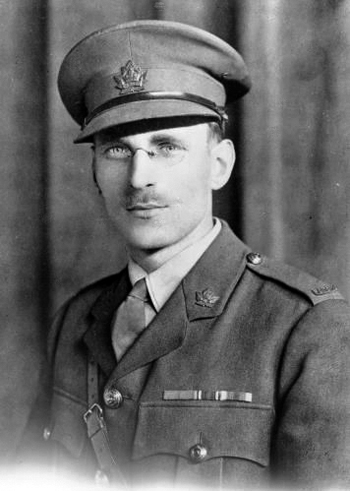
In May 1971, Canada’s third official military photographer, William Rider-Rider, sat down for an interview with archivist Peter Robertson. Rider-Rider had been hired in the spring of 1917 to work as Castle’s assistant. He later took on the role of official photographer and had produced more photographs by November 11, 1918, than either of his predecessors.
Rider-Rider told Robertson that he wished to clear the air on Ivor Castle’s famous series of four photographs. Rider-Rider had not been present when Castle shot the photos in October 1916, but he claimed to have learned the truth from another of Castle’s assistants. He explained the way in which the photographs had been meticulously altered to remove tell-tale details, such as the training rifles’ breech covers. The assistant had also explained to Rider-Rider that in the photo titled A Canadian Battalion Go Over the Top, the uppermost man — the one who seems to be making a curious hand gesture — is actually thumbing his nose at Castle for photographing a training session.
The gesture had clearly been a source of consternation for photo editors during the war — the Daily Mirror cropped it out, while the Canadian War Pictorial and Le Miroir each had the hand removed by painting over it on the print’s surface. The War Illustrated explained that the soldier was thumbing his nose at the Germans. The identity of the soldier — and whether he knew Castle would pass his photographs off as genuine — is not known.
Photography and military historians alike have since examined Castle’s photographic negatives and prints of the series and have reflected on their meaning. Robertson, the archivist who spoke directly with Rider-Rider in 1971, compared Castle’s glass-plate negatives of the series against their various prints to explain how the breech covers of the soldiers’ rifles were removed and the shell bursts were added in. However, Robertson did not use this evidence to advance an argument about Castle as a photographer or his place in the history of reportage. In a 1978 essay, Robertson broadly argued that Canada’s First World War photographs, in sum, constitute a form of historical objectivity: They have the power to illustrate our past to us. His later work, however, includes the admission: “It may be said that, once created, distorted, and magnified, myths are difficult to detect and to correct.”
Although historians have slowly uncovered the origins of Ivor Castle’s most famous photographic series, the photographer and his body of work remain relatively under-studied. Australian historian Martyn Jolly and former Canadian War Museum art historian Laura Brandon have examined Castle’s image The Taking of Vimy Ridge — which was the centrepiece at Castle’s second exhibition of war photographs in July 1917 — and found that it, too, was manipulated. Dead bodies were added to the foreground, while shell bursts were made to fill the sky. Brandon argues that this rare instance of adding dead Canadians to a scene for exhibition purposes helped to cement in the public mind the terrible cost of victory at Vimy. Castle’s tendency to stage or to manipulate photographs for the gallery wall indicates that he likely produced more such images, though not all have yet been identified by historians. At the same time, the extent to which Castle edited his photographs is unknown, and certainly he produced genuine, unretouched images, too.
But all photographic objects have the capacity to take on different meanings as the world around them changes. When a photograph is displayed publicly it acquires a new life — one that involves how a curator conceives of it and how a spectator perceives it. Many war photographs are as malleable as Castle’s turned out to be. He simply pushed his over the top.
We hope you’ll help us continue to share fascinating stories about Canada’s past by making a donation to Canada’s History Society today.
We highlight our nation’s diverse past by telling stories that illuminate the people, places, and events that unite us as Canadians, and by making those stories accessible to everyone through our free online content.
We are a registered charity that depends on contributions from readers like you to share inspiring and informative stories with students and citizens of all ages — award-winning stories written by Canada’s top historians, authors, journalists, and history enthusiasts.
Any amount helps, or better yet, start a monthly donation today. Your support makes all the difference. Thank you!
Themes associated with this article
Advertisement

